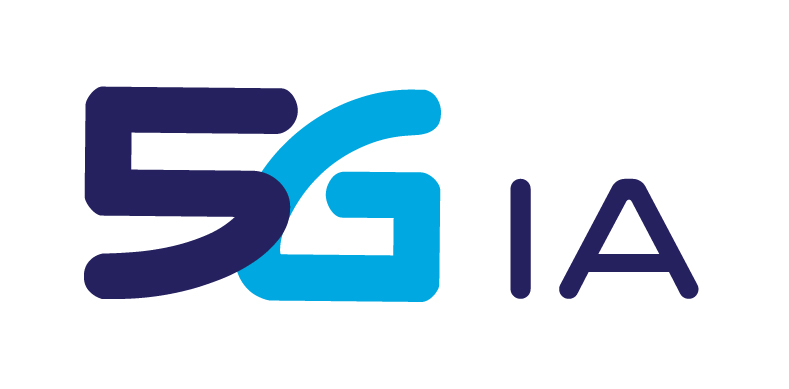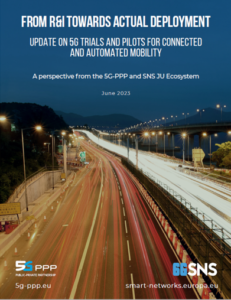

- About us
- Getting Involved
- Plans & Papers
- Events
- European 5G Activities
- Media & News
- Contact
Update on Trials and Pilots for Connected and Automated Mobility
FROM R&I TOWARDS ACTUAL DEPLOYMENT
UPDATE ON 5G TRIALS AND PILOTS FOR CONNECTED
AND AUTOMATED MOBILITY
A perspective from the 5G-PPP and SNS JU Ecosystem
 Based on the first issue of this brochure, which was published in May 2021, this updated version reflects on the lessons learnt from recently finished ICT-18 call CAM projects in 2022, plus updates from the ongoing ones under the 5G-PPP programme, such as the ICT-53 call projects. Since the middle of 2022, the Smart Networks and Services Joint Undertaking (SNS JU) framework has succeeded the 5G-PPP programme in the European context, and all continuing 5G-PPP projects are also inspired by 5G evolution and 6G topics discussed at SNS JU level and worldwide.
Based on the first issue of this brochure, which was published in May 2021, this updated version reflects on the lessons learnt from recently finished ICT-18 call CAM projects in 2022, plus updates from the ongoing ones under the 5G-PPP programme, such as the ICT-53 call projects. Since the middle of 2022, the Smart Networks and Services Joint Undertaking (SNS JU) framework has succeeded the 5G-PPP programme in the European context, and all continuing 5G-PPP projects are also inspired by 5G evolution and 6G topics discussed at SNS JU level and worldwide.
Along this path, 5G technology used in the projects has been the first communication technology, the first generation that has tried to systematically integrate and support many CAM services which can be supported by 5G (3GPP Rel.15/16/17). In addition, the 5G ecosystem has also been developing an end-to-end analysis of the different elements that must come together for a successful deployment of advanced CAM services; this includes, among many other aspects, all regulatory requirements and rules, deployment options and cooperation models, legal and business implications, as well as cross-vendor, cross-operator, and cross-national/cross-border considerations.
5G is now entering into a phase of massive deployment. However, many challenges are still to be solved and it can already be anticipated that, even though 5G is going to create a revolution in many sectors, including CAM, and bring a huge positive impact into the European economy and society, some limitations for end-to-end solutions will prevail. As a broader take-away, one of the biggest challenges in the CAM domain lies on the requirement of a deeper 5G-V2X integration into the existing and evolving ADAS (Advanced Driver-Assistance Systems) across the vehicle manufacturers. Also, internationally agreed network profiles for 5G slicing and other network deployment requirements and configurations are needed to enable an interoperable and cross-border European, respectively global, CAM mass market.
As it was stated in the 5G Strategic Deployment Agenda for Road Transportation (5G SDA) released in 2020 by key stakeholder associations, 5G will be a booster for the realization of CAM and, therefore, bring all societal benefits to reality. An update of the 5G SDA is currently being prepared for release in late Q4 2023, also considering the synergies of 5G communication between Road and Rail Transportation, and further transportation modes, such as inland waterways, costal maritime and eventually lower airspace.
For this reason, the 5G Public Private Partnership (5G PPP) and its successor 6G-SNS JU, which aim at ensuring that Europe leads the development and deployment of 5G and beyond in Europe, has been continuously funding since 2015 several projects which contribute to designing, developing, testing, validating, and promoting the potential of 5G-based vehicular communications (so-called V2X communications) for CAM. It is worth noting that the term V2X refers to communication between a vehicle and anything else, including V2V (vehicle-to-vehicle),
V2N (vehicle-to-network), V2I (vehicle-to-infrastructure), and V2P (vehicle-to-pedestrian / vulnerable road user). The focus of these projects is on V2N CAM based on 5G networks, while direct short-range communication on the side link (LTE PC5) has been used as a complement, but not in all projects and their respective use cases and not for ITS Day-1 safety scenarios.
This brochure aims at providing an updated schematic and visual summary of the key use cases, key performance indicators, and tests and pilots being conducted in the context of research and innovation projects funded by 5G-PPP, which contribute to enabling efficient and reliable 5G-V2X communications for CAM. Moreover, first lessons learnt from finished projects are summarized at the end.
Download the Brochure here:
FROM R&I TOWARDS ACTUAL DEPLOYMENT
UPDATE ON 5G TRIALS AND PILOTS FOR CONNECTED AND AUTOMATED MOBILITY
Edited by the 6G-IA 5G for CAM Working Group Chairs
June 202 – 6G IA 5G for CAM Working Group





